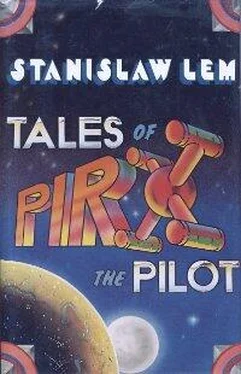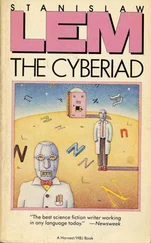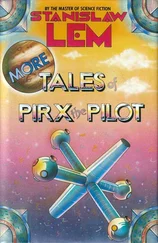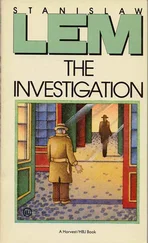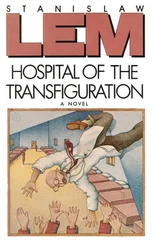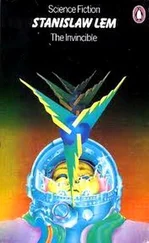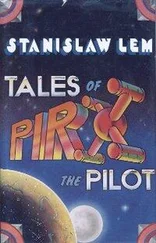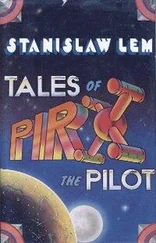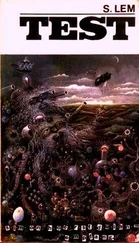There were rumors that the conventional cribsheet was about to be replaced by an electronic pony, a microbrain the size of a cherry pit that could be inserted in the ear, or under the tongue, and be programmed to supply whatever information was needed at the moment. But Pirx was skeptical, reasoning—not without a certain logic—that such an invention would nullify the need for any cadets. For the time being, though, there weren’t any, and so he had little choice but to give a word-for-word recap of the entire mission—and repeat it he did, committing only one error in the process, but that being a fairly serious one: he confused the minutes and seconds of time with the seconds and minutes of latitude and longitude. He waited for the next round, sweating buckets in his antiperspiration suit, underneath the thick coverall of his space suit. He was asked to give another recap, which he did, though so far not a single word of what he said had made the slightest impression on him. His only thought at the moment was: Wow! They’re really giving me the third degree!
Clutching the pony in his left hand, he handed over his navigation book with the other. Making the cadets give an oral recitation of the mission was a deliberate hoax, since they always got it in writing, anyhow, complete with the basic diagrams and charts. The CO slipped the flight envelope into the little pocket lining the inside cover, and returned the book to him.
“Pilot Pirx, are you ready for blast-off?”
“Ready!” Pirx replied. Right now he was conscious of only one desire: to be in the control cabin. He dreamed of the moment when he could unzip his space suit, or at least the neck ring.
The CO stepped back.
“Board your rocket!” he bellowed in a magnificent voice, a voice that rose above the muffled roar of the cavernous hangar like a cathedral bell.
Pirx did an about-face, grabbed the red pennon, bumped against the railing but regained his balance in the nick of time, and marched down the narrow gangway like a zombie. He was not halfway across when Boerst—looking for all the world like a soccer ball from the back—had already boarded his rocket ship.
He stuck his legs inside, braced himself against the metal housing, and scooted down the flexible chute without so much as touching the ladder rungs—“Rungs are only for the goners,” was one of Bullpen’s pet sayings—and proceeded to “button up” the cabin. They had practiced it a hundred, even a thousand times, on mock-ups and on a real manhatch dismantled from a rocket and mounted in the training hangar. It was enough to make a man giddy: a half-turn of the left crank, a half-turn of the right one, gasket control, another half-turn of both cranks, clamp, airtight pressure control, inside manhole plate, meteor deflector shield, transfer from air lock to cabin, pressure valve, first one crank, then the other, and last of all the crossbar—whew!
It crossed his mind that, while he was still busy turning the manhole cover, Boerst was probably already settled in his glass cocoon. But then, he told himself, what was the rush? The lift-offs were always staggered at six-minute intervals to avoid a simultaneous launch. Even so, he was anxious to get behind the controls and hook up the radiophone—if only to eavesdrop on Boerst’s commands. He was curious to know what Boerst’s mission was.
The interior lights automatically went on the moment he closed the outside hatch. After sealing off the cabin, he climbed a small flight of steps padded with a rough but pliant material, before reaching the pilot’s seat.
Now why in hell’s name did they have to squeeze the pilot into a glass blister three meters in diameter when these one-man rockets were cramped enough as it was? wondered Pirx. The blister, though transparent, was made not of glass, of course, but of some Plexiglas material having roughly the same texture and resilience as extremely hard rubber. The pilot’s encapsulated contour couch was situated in the very center of the control room proper. Thanks to the cabin’s cone-shaped design, the pilot, by sitting in his “dentist’s chair”—as it was called in spaceman’s parlance—and rotating on its vertical axis, was able to monitor the entire instrument panel through the walls of the blister, with all its dials, meters, video screens (located fore, aft, and at the side), computer displays, astrograph, as well as that holy of holies, the trajectometer. This was an instrument whose luminous band was capable of tracking a vehicle’s flight path on a low-luster convex screen, relative to the fixed stars in the Harelsberg projection. A pilot was expected to know all the components of this projection by heart, and to be able to take a readout from virtually any position—even upside down. Once seated in a semisupine position, the pilot had, to the right and left of him, two reactor and attitude control levers, three emergency controls, six manual stick controls, the ignition and idling switches, along with the power, thrust, and purge controls. Standing just above the floor was a sprawling, spoke-wheeled hub that housed the air-conditioning system, oxygen supply, fire-protection bay, catapult (in the event of an uncontrollable chain reaction), and a cord with a loop attached to a bay containing Thermoses and food. Located just under the pilot’s feet were the braking pedals, softly padded and attached with loop straps, and the abort handle, which when activated (this was done by kicking in the glass shield and shoving it forward with the foot) jettisoned the encapsulated seat and pilot, together with a drogue chute of the ringsail variety.
Aside from having as its main function the bailing out of a pilot in an abort situation, the blister was designed with eight other reasons in mind, and under more favorable circumstances Pirx might have been able to enumerate them, though neither he nor his classmates found any of them that persuasive.
Once in the proper reclining position, he had trouble bending over at the waist to attach all the loose cables, hoses, and wires—the ones dangling from his suit—to the terminals sticking out of the seat. Every time he leaned forward, his suit would bunch up in the middle, pinching him, so that it was no wonder he confused the radio cable and the heating cable. Luckily, each was threaded differently, but he had to break out in a terrific sweat before discovering his mistake. As the compressed air instantly inflated his suit with a pshhh, he leaned back with a sigh and went to fasten his thigh and shoulder straps, using both hands.
The right strap snapped into place, but the left one was more defiant. Because of the balloon-sized neck collar, he had trouble turning around, so he had to fumble around blindly for the large snap hook. Just then he heard muffled voices coming over his earphones:
“Pilot Boerst aboard AMU-18! Lift-off on automatic count-down of zero. Attention, are you ready?”
“Pilot Boerst aboard AMU-18 and ready for lift-off on automatic countdown of zero!” the cadet fired back.
Damn that hook, anyhow! At last it clicked into place, and Pirx sank back into the soft contour couch, as bushed as if he’d just returned from a deep-space probe.
“Minus twenty-three, twenty-two, twen…” The count rambled on in his earphones with a steady patter.
It happened once that at the count of zero two cadets were launched simultaneously—the one scheduled to go first, and the one next in line. Both rockets shot up like a couple of Roman candles, less than 200 meters apart, escaping a midair collision by a mere fraction of an arc second. Or so the story went. Ever since then—again, if the rumors were to be believed—the ignition cable was activated at the very last moment, by a radio command signal issued by the launch-site commander stationed inside his glass-paneled booth—which, if true, would have made a mockery of the whole countdown.
Читать дальше
